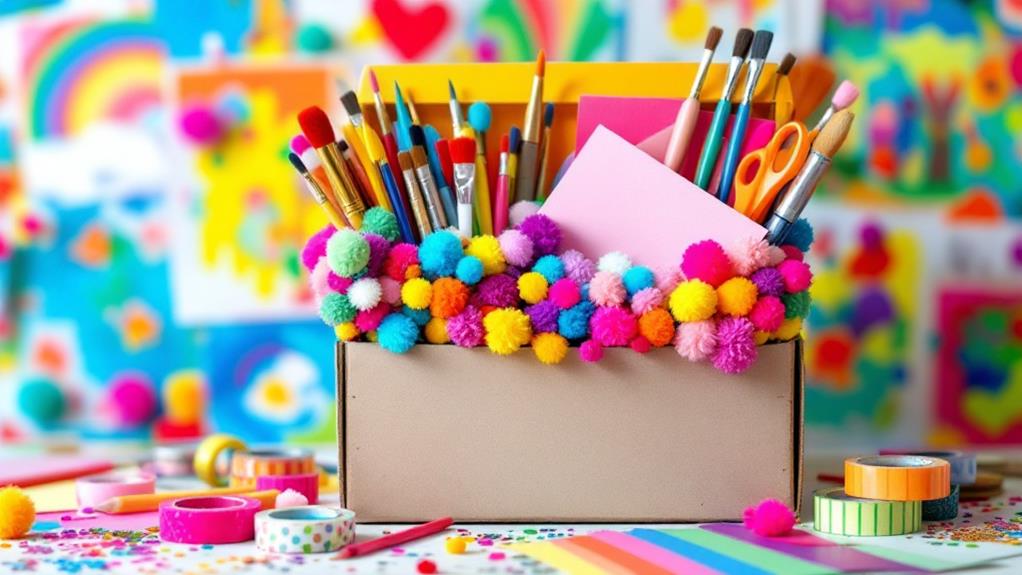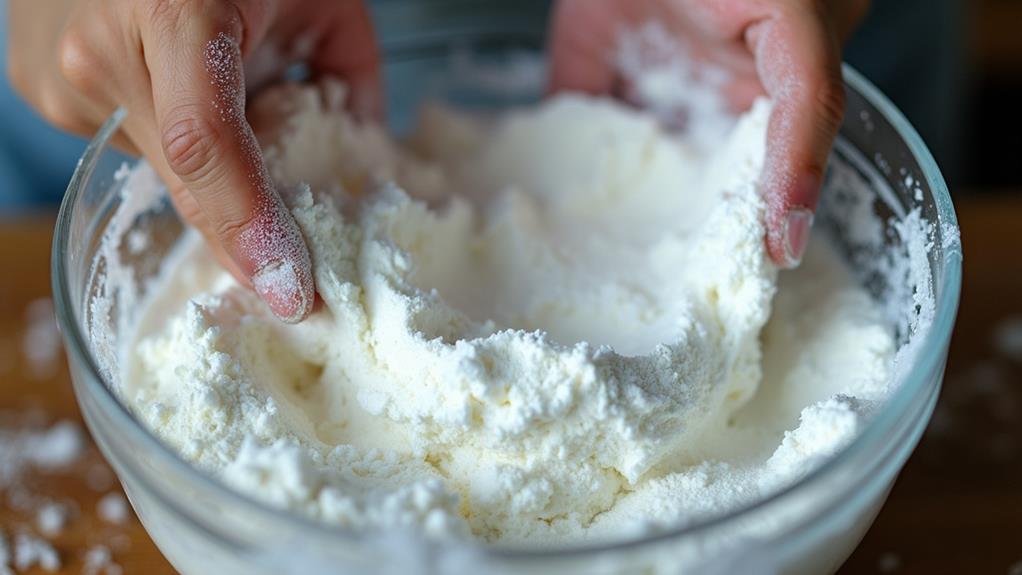What Do You Put in a Children's Craft Box?

To create a fun children's craft box, start with crucial supplies like crayons, markers, scissors, glue, and tape. Add items like construction paper, buttons, and beads, organizing smaller pieces in zipper bags. Don't forget a plastic tablecloth for easy cleanup! Consider including seasonal craft materials and instructional prompts to inspire creativity. Encourage your child to help gather supplies; this fosters ownership and excitement. Finally, keep everything organized and easily accessible for smooth crafting sessions. If you're looking for more tips on how to improve your child's crafting experience, you'll find plenty of ideas just ahead!
Craft Box Overview
A children's craft box is a fantastic way to spark creativity and independence in young artists. When you provide your child with a craft box filled with art and craft supplies, you're giving them the freedom to investigate their artistic abilities. This box should be theirs, allowing them to choose materials for their projects. Incorporating items like playdough can also improve their sensory experiences and encourage imaginative play.
Before diving into crafting, don't forget to lay down a plastic tablecloth to protect your surfaces. It makes cleanup a breeze! Encourage your child to actively participate in gathering and organizing the materials in their craft box. This fosters a sense of ownership and responsibility, which is vital for their development.
Alongside store-bought art and craft supplies, consider including household recyclables like cardboard tubes or old magazines. These items can be transformed into something new, promoting creativity and resourcefulness. Construction paper is also a must-have, as it serves as a versatile base for countless projects. By allowing your child to experiment with different materials, you're nurturing their imagination and helping them gain confidence in their creative pursuits. So, get started on building that craft box today!
Essential Materials
Building a craft box means stocking it with the right materials to inspire creativity. Start with fundamental supplies like crayons, markers, scissors, glue, and tape. These basics enable a range of projects and encourage imaginative play, which is vital for cognitive growth in children. Choose a bankers or archive box with minimum dimensions of 12 x 12 x 6 inches for adequate storage. This size guarantees you have enough room for all your crafting goodies.
To keep everything organized, use different sizes of zipper plastic bags. They're perfect for storing smaller items like buttons, beads, or stickers, making it easier for kids to find what they need. You might also consider adding optional supplies like envelopes, origami paper, or a pencil box to expand their crafting options.
Don't forget about cleanup! Including a plastic tablecloth in your craft box can save you time and effort during messy projects. With these fundamental materials, your craft box will be ready to spark creativity and provide endless fun. So gather your supplies, and watch as your little ones plunge into their next artistic adventure!
Preparation Steps
Crafting success begins with a solid preparation plan. To kick things off, familiarize yourself with the entire project by reading the instructions thoroughly. This guarantees a smooth crafting experience and helps you anticipate the necessary items for your children's craft.
Next, gather all the supplies you'll need, keeping your child's developmental stage, abilities, and interests in mind. This way, you can select appropriate materials that will engage and inspire them. Once you've collected everything, organize supplies using bags or boxes. This sorting makes it easier for children to find what they need, promoting independence during their craft time.
It's also essential to designate a clean workspace specifically for crafting activities. A tidy environment encourages creativity and minimizes distractions. Make sure the area is free from clutter and safe for your little ones to investigate their artistic side.
Lastly, involve your children in the preparation process. Allowing them to help gather materials and fill the craft box fosters a sense of ownership and excitement. When kids feel invested in the setup, they're more likely to enjoy the crafting experience even more!
Loading the Craft Box
To create an organized and inviting craft box, start by laying down a colorful plastic tablecloth and sheets of paper at the bottom. This protects surfaces and provides a workspace. Next, layer larger craft items, like construction paper and scissors, inside the box. These key items form the base for your creative endeavors.
To optimize space, use zipper plastic bags for smaller items such as markers, stickers, and pipe cleaners. This keeps everything tidy and easy to find. Don't forget to include mailing envelopes to store larger items securely, ensuring your box stays full and organized.
To personalize the craft box, clearly label it as "Craft Box" and consider adding the children's names. This not only fosters ownership but also adds excitement for the little ones. After loading everything, make sure the lid is secured to keep all materials safe and ready for future crafting sessions.
You've now created a lively, functional craft box that invites creativity. With a well-organized setup, your children can easily plunge into their imaginative projects, making each crafting experience enjoyable and hassle-free.
Craft Ideas and Sharing
Creativity flourishes when children engage in hands-on projects that spark their imagination. You can inspire your little ones with a variety of craft ideas that utilize materials from their children's craft box. Projects like Circly Snake, Stars n Stripes, and Chinese Lanterns are not only fun but also help develop fine motor skills as they cut, glue, and assemble their creations.
Encourage your kids to display their masterpieces on the refrigerator for a week. This simple act fosters pride in their work and inspires them to keep creating. A DIY Memory Game made from cereal box cardboard is another great project that improves both crafting skills and cognitive development.
Seasonal crafts allow children to connect with holiday themes and changing seasons, making their creations even more meaningful. To elevate social interaction, have your kids share their craft ideas with friends and family. You could even sit together and compile a list of projects to tackle as a group. This collaborative effort not only improves creativity but also strengthens relationships, making the crafting experience even more rewarding.
Budgeting for Craft Supplies
Engaging in creative projects can quickly lead to a need for assorted supplies, which is why budgeting for craft materials is so crucial. Start by setting a total budget of around $50 for vital craft supplies. Focus on adaptable items that can be used across different projects, maximizing their value.
Shop at discount stores like Dollar Tree, Lidl, and Aldi to find budget-friendly options. Don't overlook online platforms either, as they often provide a wider selection at competitive prices. Plan your purchases around major sales events—back-to-school sales or post-holiday clearances are perfect opportunities to snag discounts on crafting materials.
If your initial estimates exceed your budget, be ready to revise your list. Prioritize only the most necessary items, ensuring you stick to your financial limits. While shopping, keep track of small savings; they can add up and allow you to purchase extra items that improve your craft box experience. By being strategic in your budgeting for craft supplies, you can create a well-stocked box that encourages creativity without breaking the bank.
Organizing Craft Supplies

Keeping your craft supplies organized can make all the difference in how smoothly your projects go. Start by utilizing different storage solutions, like labeled bins or containers, to keep distinct types of materials easy to find. This way, you won't waste time searching for items when inspiration strikes. Consider using rolling storage carts for convenient access to frequently used supplies while maintaining a tidy crafting area.
Regularly sorting and decluttering your craft supplies is crucial. This practice guarantees your collection remains manageable and aligned with your child's current interests and abilities. Encourage your kids to help with this process; it fosters a sense of responsibility and ownership over their materials.
Designating a dedicated crafting space with clear organization not only promotes creativity but also makes clean-up after crafting activities much easier. By setting up a well-organized area, you set the stage for countless fun projects together. Remember, a clutter-free environment can inspire more creativity, so make organizing your craft supplies a priority!
Seasonal Craft Inspiration
Seasonal crafting opens up a world of fun and creativity for kids, allowing them to examine themes tied to the time of year. By using materials from your craft box, you can inspire your children to create projects that celebrate each season. Here are some ideas to spark their imagination:
- Valentine's Day Cards: Use crepe paper to make colorful hearts and sweet notes for friends and family.
- Autumn Leaf Art: Collect leaves outside and glue them onto paper plates to create beautiful fall decorations.
- Spring Flowers: Craft lively flowers with tissue paper or crepe paper to brighten up your home and learn about blooming plants.
- Winter Snowflakes: Cut out intricate snowflakes from paper plates, discussing winter weather as you create.
Incorporating natural elements, like flowers in spring or pinecones in winter, improves the crafting experience. These seasonal crafts not only foster a sense of celebration and tradition but also connect children to their environment. Encourage your kids to investigate their creativity while participating in family and community activities through these engaging projects!




